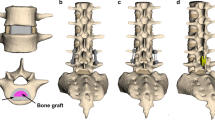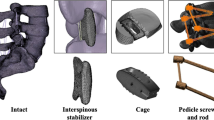Abstract
Posterior lumbar interbody fusion (PLIF) with a spacer and posterior instrument (PI) via minimally invasive surgery (MIS) restores intervertebral height in degenerated disks. To align with MIS, the spacer has to be shaped with a slim geometry. However, the thin spacer increases the subsidence and migration after PLIF. This study aimed to propose a new lumbar fusion approach using bone cement to achieve a larger supporting area than that achieved by the currently used poly aryl-ether-ether-ketone (PEEK) spacer and assess the feasibility of this approach using a sawbone model. Furthermore, the mechanical responses, including the range of motion (ROM) and bone stress with the bone cement spacer were compared to those noted with the PEEK spacer by finite element (FE) simulation. An FE lumbar L3–L4 model with PEEK and bone cement spacers and PI was developed. Four fixing conditions were considered: intact lumbar L3–L4 segment, lumbar L3–L4 segment with PI, PEEK spacer plus PI, and bone cement spacer plus PI. Four kinds of 10-NM moments (flexion, extension, lateral bending, and rotation) and two different bone qualities (normal and osteoporotic) were considered. The bone cement spacer yielded smaller ROMs in extension and rotation than the PEEK spacer, while the ROMs of the bone cement spacer in flexion and lateral bending were slightly greater than with the PEEK spacer. Compared with the PEEK spacer, peak contact pressure on the superior surface of L4 with the bone cement spacer in rotation decreased by 74% (from 8.68 to 2.25 MPa) and 69.1% (from 9.1 to 2.82 MPa), respectively, in the normal and osteoporotic bone. Use of bone cement as a spacer with PI is a potential approach to decrease the bone stress in lumbar fusion and warrants further research.








Similar content being viewed by others
References
Balague F, Mannion AF, Pellise F, Cedraschi C (2012) Non-specific low back pain. Lancet 379(9814):482–491. https://doi.org/10.1016/s0140-6736(11)60610-7
Parthan A, Evans CJ, Le K (2006) Chronic low back pain: epidemiology, economic burden and patient-reported outcomes in the USA. Exp Rev Pharmacoecon Outcomes Res 6(3):359–369. https://doi.org/10.1586/14737167.6.3.359
Niu G, Yang J, Wang R, Dang S, Wu EX, Guo Y (2011) MR imaging assessment of lumbar intervertebral disk degeneration and age-related changes: apparent diffusion coefficient versus T2 quantitation. AJNR Am J Neuroradiol 32(9):1617–1623. https://doi.org/10.3174/ajnr.A2556
Kwong Y, Rao N, Latief K (2011) MDCT findings in Baastrup disease: disease or normal feature of the aging spine? AJR Am J Roentgenol 196(5):1156–1159. https://doi.org/10.2214/ajr.10.5719
Chou R, Atlas SJ, Stanos SP, Rosenquist RW (2009) Nonsurgical interventional therapies for low back pain: a review of the evidence for an American Pain Society clinical practice guideline. Spine 34(10):1078–1093. https://doi.org/10.1097/BRS.0b013e3181a103b1
Carey TS, Garrett JM, Jackman AM (2000) Beyond the good prognosis. Examination of an inception cohort of patients with chronic low back pain. Spine 25(1):115–120
Kienle A, Graf N, Wilke HJ (2016) Does impaction of titanium-coated interbody fusion cages into the disc space cause wear debris or delamination? Spine J 16(2):235–242. https://doi.org/10.1016/j.spinee.2015.09.038
Topuz K, Colak A, Kaya S, Simsek H, Kutlay M, Demircan MN, Velioglu M (2009) Two-level contiguous cervical disc disease treated with peek cages packed with demineralized bone matrix: results of 3-year follow-up. Eur Spine J 18(2):238–243. https://doi.org/10.1007/s00586-008-0869-5
Wang B, Zhu Y, Jiao Y, Wang F, Liu X, Zhu H, Tu G, Liang D (2014) A new anterior-posterior surgical approach for the treatment of cervical facet dislocations. J Spin Disord Tech 27(3):E104–E109. https://doi.org/10.1097/BSD.0b013e318291c9f9
Bevevino AJ, Kang DG, Lehman RA Jr, Van Blarcum GS, Wagner SC, Gwinn DE (2014) Systematic review and meta-analysis of minimally invasive transforaminal lumbar interbody fusion rates performed without posterolateral fusion. J Clin Neurosci 21(10):1686–1690. https://doi.org/10.1016/j.jocn.2014.02.021
Kraiwattanapong C, Arnuntasupakul V, Kantawan R, Keorochana G, Lertudomphonwanit T, Sirijaturaporn P, Thonginta M (2018) Malposition of cage in minimally invasive oblique lumbar interbody fusion. Case Rep Orthop 2018:9142074. https://doi.org/10.1155/2018/9142074
Patel NB, Dodd ZH, Voorhies J, Horn EM (2015) Minimally invasive lateral transpsoas approach for spinal discitis and osteomyelitis. J Clin Neurosci 22(11):1753–1757. https://doi.org/10.1016/j.jocn.2015.03.061
Soriano-Baron H, Newcomb A, Malhotra D, Palma AE Jr, Martinez-Del-Campo E, Crawford NR, Theodore N, Kelly BP, Kaibara T (2018) Biomechanical analysis of an expandable lumbar interbody spacer. World Neurosurg 114:e616–e623. https://doi.org/10.1016/j.wneu.2018.03.041
Soriano-Baron H, Newcomb A, Malhotra D, Martinez Del Campo E, Palma AE Jr, Theodore N, Crawford NR, Kelly BP, Kaibara T (2019) Biomechanical effects of an oblique lumbar PEEK cage and posterior augmentation. World Neurosurg 126:e975–e981. https://doi.org/10.1016/j.wneu.2019.02.200
Kim MC, Chung HT, Cho JL, Kim DJ, Chung NS (2013) Subsidence of polyetheretherketone cage after minimally invasive transforaminal lumbar interbody fusion. J Spin Disord Tech 26(2):87–92. https://doi.org/10.1097/BSD.0b013e318237b9b1
Le TV, Baaj AA, Dakwar E, Burkett CJ, Murray G, Smith DA, Uribe JS (2012) Subsidence of polyetheretherketone intervertebral cages in minimally invasive lateral retroperitoneal transpsoas lumbar interbody fusion. Spine 37(14):1268–1273. https://doi.org/10.1097/BRS.0b013e3182458b2f
Lin D, Hao J, Li L, Wang L, Zhang H, Zou W, Lian K (2017) Effect of bone cement volume fraction on adjacent vertebral fractures after unilateral percutaneous kyphoplasty. Clin Spine Surg 30(3):E270–E275. https://doi.org/10.1097/bsd.0000000000000204
Semaan H, Obri T, Bazerbashi M, Paull D, Liu X, Sarrouj M, Elgafy H (2018) Clinical outcome and subsequent sequelae of cement extravasation after percutaneous kyphoplasty and vertebroplasty: a comparative review. Acta Radiol 59(7):861–868. https://doi.org/10.1177/0284185117732599
Tan JS, Bailey CS, Dvorak MF, Fisher CG, Cripton PA, Oxland TR (2007) Cement augmentation of vertebral screws enhances the interface strength between interbody device and vertebral body. Spine 32(3):334–341. https://doi.org/10.1097/01.brs.0000253645.24141.21
Weiser L, Huber G, Sellenschloh K, Viezens L, Puschel K, Morlock MM, Lehmann W (2018) Time to augment?! Impact of cement augmentation on pedicle screw fixation strength depending on bone mineral density. Eur Spine J 27(8):1964–1971. https://doi.org/10.1007/s00586-018-5660-7
Lee YH, Chung CJ, Wang CW, Peng YT, Chang CH, Chen CH, Chen YN, Li CT (2016) Computational comparison of three posterior lumbar interbody fusion techniques by using porous titanium interbody cages with 50% porosity. Comput Biol Med 71:35–45. https://doi.org/10.1016/j.compbiomed.2016.01.024
Chen YN, Lee PY, Chang CH, Chang CW, Ho YH, Li CT, Peng YT (2016) Computational comparison of tibial diaphyseal fractures fixed with various degrees of prebending of titanium elastic nails and with and without end caps. Injury 47(10):2339–2346. https://doi.org/10.1016/j.injury.2016.07.001
Coe JD, Zucherman JF, Kucharzyk DW, Poelstra KA, Miller LE, Kunwar S (2016) Multiexpandable cage for minimally invasive posterior lumbar interbody fusion. Med Devices 9:341–347. https://doi.org/10.2147/mder.s112523
Rancourt D, Shirazi-Adl A, Drouin G, Paiement G (1990) Friction properties of the interface between porous-surfaced metals and tibial cancellous bone. J Biomed Mater Res 24(11):1503–1519. https://doi.org/10.1002/jbm.820241107
Woldtvedt DJ, Womack W, Gadomski BC, Schuldt D, Puttlitz CM (2011) Finite element lumbar spine facet contact parameter predictions are affected by the cartilage thickness distribution and initial joint gap size. J Biomech Eng 133(6):061009. https://doi.org/10.1115/1.4004287
Polikeit A, Nolte LP, Ferguson SJ (2003) The effect of cement augmentation on the load transfer in an osteoporotic functional spinal unit: finite-element analysis. Spine 28(10):991–996. https://doi.org/10.1097/01.brs.0000061987.71624.17
Lu YM, Hutton WC, Gharpuray VM (1996) Do bending, twisting, and diurnal fluid changes in the disc affect the propensity to prolapse? A viscoelastic finite element model. Spine 21(22):2570–2579
Wu SH, Li Y, Zhang YQ, Li XK, Yuan CF, Hao YL, Zhang ZY, Guo Z (2013) Porous titanium-6 aluminum-4 vanadium cage has better osseointegration and less micromotion than a poly-ether-ether-ketone cage in sheep vertebral fusion. Artif Organs 37(12):E191–E201. https://doi.org/10.1111/aor.12153
Ahn YH, Chen WM, Lee KY, Park KW, Lee SJ (2008) Comparison of the load-sharing characteristics between pedicle-based dynamic and rigid rod devices. Biomed Mater 3(4):044101. https://doi.org/10.1088/1748-6041/3/4/044101
Dahl MC, Ellingson AM, Mehta HP, Huelman JH, Nuckley DJ (2013) The biomechanics of a multilevel lumbar spine hybrid using nucleus replacement in conjunction with fusion. Spine J 13(2):175–183. https://doi.org/10.1016/j.spinee.2012.11.045
Wilke HJ, Heuer F, Schmidt H (2009) Prospective design delineation and subsequent in vitro evaluation of a new posterior dynamic stabilization system. Spine 34(3):255–261. https://doi.org/10.1097/BRS.0b013e3181920e9c
Heuer F, Schmidt H, Klezl Z, Claes L, Wilke HJ (2007) Stepwise reduction of functional spinal structures increase range of motion and change lordosis angle. J Biomech 40(2):271–280. https://doi.org/10.1016/j.jbiomech.2006.01.007
Perez MA, Nuno N, Madrala A, Garcia-Aznar JM, Doblare M (2009) Computational modelling of bone cement polymerization: temperature and residual stresses. Comput Biol Med 39(9):751–759. https://doi.org/10.1016/j.compbiomed.2009.06.002
Wilson DC, Connolly RJ, Zhu Q, Emery JL, Kingwell SP, Kitchel S, Cripton PA, Wilson DR (2012) An ex vivo biomechanical comparison of a novel vertebral compression fracture treatment system to kyphoplasty. Clin Biomech 27(4):346–353. https://doi.org/10.1016/j.clinbiomech.2011.11.001
Beall DP, Olan WJ, Kakad P, Li Q, Hornberger J (2015) Economic analysis of Kiva VCF treatment system compared to balloon kyphoplasty using randomized Kiva Safety and Effectiveness Trial (KAST) data. Pain Phys 18(3):E299–E306
Acknowledgements
The authors disclosed receipt of the following financial support for the research, authorship, and/or publication of this article: This work was supported by National Cheng Kung University—Show Chwan Health Care System R&D Project (NCKUSCMH10612).
Author information
Authors and Affiliations
Corresponding authors
Ethics declarations
Conflict of interest
All Authors declare that they have no conflict of interest.
Additional information
Publisher's Note
Springer Nature remains neutral with regard to jurisdictional claims in published maps and institutional affiliations.
Rights and permissions
About this article
Cite this article
Chang, CW., Chung, YH., Chang, CJ. et al. Computational comparison of bone cement and poly aryl-ether-ether-ketone spacer in single-segment posterior lumbar interbody fusion: a pilot study. Phys Eng Sci Med 43, 163–173 (2020). https://doi.org/10.1007/s13246-019-00832-8
Received:
Accepted:
Published:
Issue Date:
DOI: https://doi.org/10.1007/s13246-019-00832-8




